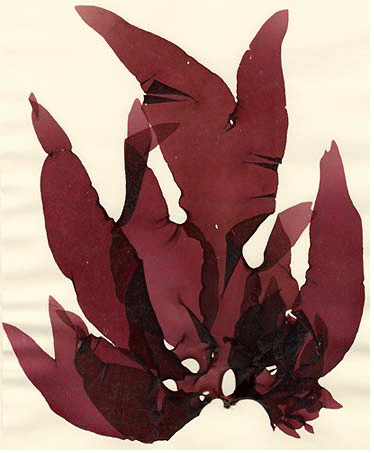Grateloupia lanceolata (Okamura) Kawaguchi is a member of the Rhodophyceae, or red algae group.
The body is thick and firm. A short stalk appressorium with width is previously attached a little. It is vertical by appressorium. There are a lot zonal, oblong, and a kidney type etc. of the shape of the appressorium.

Moreover, it separates into two in the upper part of the appressorium, and there is the one that the point is pointed out, too. The origin of the scientific name originates the fact that it is flat, long and slender, and it is sharp ahead. The medullary layer consists of a close filamentous cell, it queues up from small spheroidal the cortex in an oval close cell in the integument layer, and a little large cell piles up in the ranging endodermis layer. It is necessary to distinguish between the `turu turu` and `tanbanori` difficultly only by the feeling the surface. It is called according to the region `akahanba`, and it is used for food.
Grateloupia lamceolata belongs to the Rhodophyta Gigartinales Halymeniaceae.
It is widely distributed in Japanese whole areas except Hokkaido such as the Honshu, Shikoku and Kyusyu. Moreover,it is distributed not only Japan but also in a Korean peninsula. Inside harbor, it often becomes a primary.
It grows in a calm environment like the basin and the littoral region.When the tides pull it most in a quiet place of the wave, it grows on rocks in the vicinity near the surface of the sea. Moreover, it lives also in the part always soaked in seawater. It is necessary to correspond to strong waves right under the ebb tide line etc. though such a place is a secure setting for the living thing. In the inside the harbor, it often becomes dominant.
It is possible to grow all the year round. The group of the cystocarp appears on the surface of the body and it becomes a macula pattern when maturing. Origin of Japanese name, comes from spots and showing `Fudarake` there is this macula. There is considerably a viscosity. Length is 20~50cm, and one that becomes 1m in length usually. Width is 7~15cm. Surface is a smooth leather . The living body is very varied with red, yellow, and green. It often is near the coast at the turn of the season from summer to autumn and it goes up. It adheres to paper when making it to a drying.
In Kochi Prefecture, it is possible to confirm it in all seas. Confirming it is especially easy, and most beautiful one is Usa.


I didn’t know the living body is red , yellow , and green.
I surprised Fudaraku becomes 1m.
LikeLike